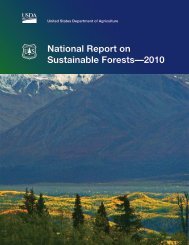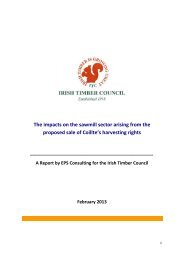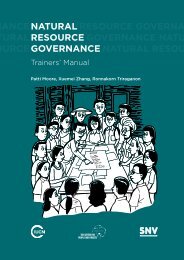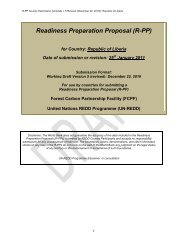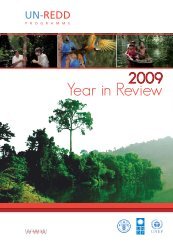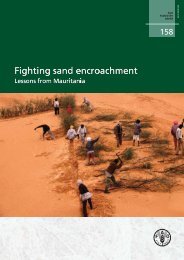pdf 1242 KByte - JIKO
pdf 1242 KByte - JIKO
pdf 1242 KByte - JIKO
Create successful ePaper yourself
Turn your PDF publications into a flip-book with our unique Google optimized e-Paper software.
Policy Paper: Assessing prerequisites for market-based REDD+ activities 23<br />
10% of the worlds forests are currently officially managed by communities (White / Martin 2002 cit. in<br />
Agrawal / Angelsen 2009). If informal use and control is being considered, this fraction is even higher.<br />
In the past decades, the failure of national governments in managing forests due to corruption and lax law<br />
enforcement called for a stronger involvement of communities. Several initiatives aimed at decentralizing the<br />
management of forest and increase local community control while experiences have shown that communities<br />
can actually manage forests in a sustainable way (Agrawal / Angelsen 2009).<br />
Community forest management including higher ownership and management responsibility and autonomous<br />
rulemaking has been identified to correlate strongly with positive forest protection outcomes and better equity<br />
outputs (Hayes / Persha 2010). However, there are also serious risks, including a rise in local corruption<br />
and increased vulnerability of communities. Therefore, national policies should prevent elites capturing the<br />
benefits accruing from REDD+ and ensure benefits are transferred to the individual community members.<br />
Governments will further need to develop procedures that ensure risks are being shared between communities<br />
and the government (Costenbader 2011). Furthermore, tenure may be an issue here. Even in cases where<br />
tenure reforms have been implemented, communities face numerous obstacles before benefiting from the<br />
changes on the ground, as Larson (2010) has shown in her comparative study. Challenges identified comprise<br />
unfavourable state policies, complex bureaucracies, as well as high upfront costs and the lack of credit<br />
facility (Larson 2010).<br />
3.3.3 Channelling of international funds<br />
A national REDD+ architecture would need to disburse resources to REDD+ actions and establish a system<br />
to allocate resources for emission reductions and carbon stock enhancement. In doing so, countries must<br />
ensure legitimate benefit sharing as well as compliance with national and internationally agreed procedures.<br />
Vatn and Angelsen (2009) identify four different options REDD+ countries have at their disposal when establishing<br />
their national REDD+ funding architecture.<br />
The first option would be national market-based funding, where payments would be channelled from the<br />
international carbon markets to local projects through market directed intermediaries. This structure would<br />
be similar to the existing CDM market and the voluntary carbon market with activities being typically project-based.<br />
Expectations are high that such a project-based approach has advantages in terms of efficiency,<br />
since project developers may be able to identify those activities with the lowest opportunity costs while at the<br />
same time costs for bureaucracy will be held low. However, these advantages may be reduced when the scale<br />
of REDD+ increases. Furthermore, a project-based solution also poses some serious risks with leakage being<br />
one main concern due to the small scale of activities (cf. section 3.3.1). With regard to equity, the pivotal<br />
role private actors are playing in such an architecture raises some concerns, since these actors may be predominantly<br />
driven by the interest in carbon revenues rather than achieving other environmental and development<br />
goals. This could also influence regional distribution of projects since private actors are expected to<br />
be risk adverse and will therefore implement projects in areas with formalised property rights. The strong<br />
position of private actors may further marginalise the state and local authorities, particularly if the scale of<br />
REDD+ increases (Vatn / Angelsen 2009).<br />
One second option is a fund established separate of the state administration. Here, funding could not only<br />
be channelled to individual projects but might include payments to national programmes. With a structure<br />
similar to the existing conservation trust funds (CTF), such an approach is expected to provide stable longterm<br />
funding and provide stability in times of political or economic uncertainty, making them better suited<br />
Nicolas Kreibich, Christof Arens and Wolfgang Sterk<br />
Wuppertal Institute




